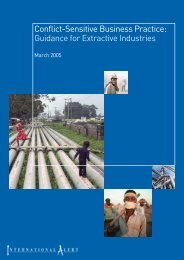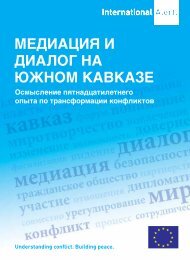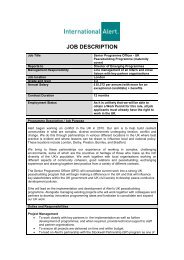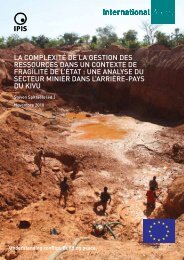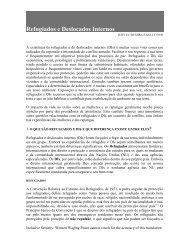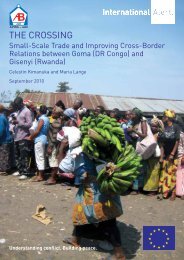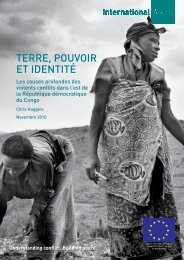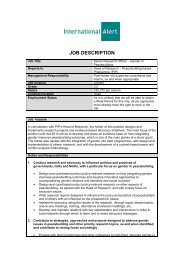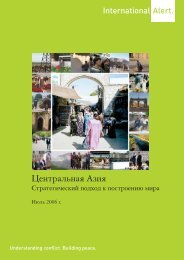What peace and Whose? - Internal Displacement Monitoring Centre
What peace and Whose? - Internal Displacement Monitoring Centre
What peace and Whose? - Internal Displacement Monitoring Centre
You also want an ePaper? Increase the reach of your titles
YUMPU automatically turns print PDFs into web optimized ePapers that Google loves.
<strong>What</strong> <strong>peace</strong> <strong>and</strong> whose?19subsequent dialogue forum, such as a national reconciliation conference or a constitutional reviewconference. Another approach can be dialogue among narrower groups, focusing on the <strong>peace</strong>vision for a particular part of the country or a particular theme or issue, such as the economy ortruth <strong>and</strong> reconciliation.In all cases, <strong>peace</strong>building dialogue is an opportunity for participants to moveaway from current positions or short-term concerns – about which they may bein disagreement – <strong>and</strong> to discuss longer-term ideas <strong>and</strong> issues about which theymay not have a fixed position. Conducted well, such dialogue can:• Bring people together who would otherwise not come together, <strong>and</strong> discussissues which might otherwise seem off-limits;• Allow those who think they know what others think <strong>and</strong> st<strong>and</strong> for (whattheir positions are) to discover that they have more interests in common witheach other than they had thought;• Provide an opportunity for participants to look at issues afresh, as freethinkingindividuals, because they participate as individuals, rather thanrepresentatives;• Stimulate participants to take the insights gained during the dialogue awaywith them into their normal everyday roles, <strong>and</strong> to continue the dialoguewith others <strong>and</strong> to initiate new actions they would not otherwise have done.‘It is incumbenton the leadershipsof the north <strong>and</strong>the south to worktogether to avoidhostilities <strong>and</strong> tobring benefits to thepeople of the north<strong>and</strong> the south.’Lazaro Sumbeiywo, chief mediator<strong>and</strong> chair of CPA <strong>peace</strong> talks,speech, May 2011Box 4: <strong>What</strong> is <strong>peace</strong>building?“Peacebuilding” covers a broad set of processes <strong>and</strong> actions by any party with the capacity to influencethe prospects for <strong>peace</strong>. <strong>What</strong> sets <strong>peace</strong>building aside from other processes (such as development,economic growth, <strong>and</strong> humanitarian aid) is simply that it is done with the express purpose of buildinglasting <strong>peace</strong>, <strong>and</strong> is based on as complete an underst<strong>and</strong>ing as possible of the factors that contributeto or prevent <strong>peace</strong>.In short, <strong>peace</strong>building is the set of processes whose purpose is to gain, maintain <strong>and</strong> strengthen<strong>peace</strong>. This means activities <strong>and</strong> interventions which are designed to influence events, processes <strong>and</strong>actors to create new outcomes, so that <strong>peace</strong>ful conditions are gained <strong>and</strong>/or maintained. This is alarger goal than simply preventing or stopping violence, or resolving conflicts.Peacebuilding in South Sudan <strong>and</strong> SudanIn developing a shared vision for <strong>peace</strong> in South Sudan <strong>and</strong> Sudan, <strong>and</strong> finding approaches <strong>and</strong>methods which will be effective, it can be helpful to ask questions <strong>and</strong> to identify some principlesfor <strong>peace</strong>building. For example:• Who is responsible for <strong>peace</strong> in South Sudan <strong>and</strong> Sudan?• Who needs to be involved for a deeper, more stable <strong>peace</strong> to be built?• <strong>What</strong> needs to change in existing attitudes <strong>and</strong> approaches to <strong>peace</strong>building?• If the same approaches are taken as before, why <strong>and</strong> how will the results be different?• <strong>What</strong> can be learned from examples elsewhere?• If different approaches are taken, what approaches <strong>and</strong> actions are best?Answers to these questions should come first <strong>and</strong> foremost from within South Sudan <strong>and</strong> Sudan,for example as part of dialogue <strong>and</strong> discussion which leads to a statement of principles for<strong>peace</strong>building. (In a similar way, declarations of principles emerged from Sudan’s many <strong>peace</strong> talksin the past <strong>and</strong> became foundations of <strong>peace</strong> processes.) However, considering the history <strong>and</strong>





